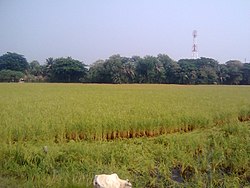Dacope Upazila
This article needs additional citations for verification. (November 2013) |
Dacope
দাকোপ | |
|---|---|
 Rice fields at Chalna | |
 | |
| Coordinates: 22°34.3′N 89°30.7′E / 22.5717°N 89.5117°E | |
| Country | |
| Division | Khulna |
| District | Khulna |
| Area | |
• Total | 991.56 km2 (382.84 sq mi) |
| Population | |
• Total | 159,369 |
| • Density | 160/km2 (420/sq mi) |
| Time zone | UTC+6 (BST) |
| Postal code | 9270[2] |
| Website | dakop |
Dacope (Bengali: দাকোপ) is an upazila of Khulna District in the Division of Khulna, Bangladesh. Dacope Thana was established in 1906 and was converted into an upazila in 1983.[3]
Geography
[edit]Dacope Upazila has a total area of 991.58 square kilometres (382.85 sq mi).[4] It borders Batiaghata Upazila to the north, Rampal and Mongla Upazilas of Bagerhat District to the east, the confluence of the Pasur and Shibsa Rivers at the Kunga estuary to the south, and Koyra and Paikgachha Upazilas to the west. Other main rivers are the Manki and Bhadra.[3]
Demographics
[edit]As of the 2011 Census of Bangladesh, Dacope upazila had 36,597 households and a population of 152,316. 26,092 (17.13%) were under 10 years of age. Dacope had an average literacy rate of 56.00%, compared to the national average of 51.8%, and a sex ratio of 997 females per 1000 males. 14,188 (9.31%) of the population lived in urban areas.[6][7]
According to the 1991 Bangladesh census, Dacope had a population of 143,131. Males constituted 52.25% of the population, and females 47.75%. The population aged 18 or over was 78,759. Dacope had an average literacy rate of 37.6% (7+ years), compared to the national average of 32.4%.[8] It is the only Hindu majority upazila in Bangladesh.
Administration
[edit]Dacope Upazila is divided into Chalna Municipality and ten union parishads: Bajua, Banishanta, Dacope, Kailashganj, Kamarkhola, Khulna Range, Loudob, Pankhali, Sutarkhali, and Tildanga Union. The union parishads are subdivided into 26 mauzas and 97 villages.[4]
Chalna Municipality is subdivided into 9 wards and 15 mahallas.[4] There is a War of Liberation mass killing site at Bazua High School courtyard and a War of Liberation monument, Smriti Amlan (in front of the upazila parisad building).[3]
NGO activities
[edit]Operationally important NGOs are BRAC,NGO Forum For Public Health, Proshika, World Vision, Gonoshahajjo Sangstha, HEED Bangladesh, Step, and Prodipon.[3]
Education
[edit]Colleges
[edit]- Bajua Surendra Nath College, Dacope, Khulna
- Chalna College (1995), Chalna Bazar, Chalna Municipality, Dacope, Khulna
- Chalna M.M. Degree college
- Chalna Mohila Mohabidyaloy, Chalna Bazar, Dacope, Khulna
- L.B.K. Government Mohila College, Dacope, Khulna
High schools
[edit]- Paschim Kamini Basia Rashkhola High School
- Paschim Bajua Secondary School
- Batbunia Collegiate School
- Gunari Shital Chandra High School
- Abul Hosain Girls High School
- Burir Dabur SESDP Model High School
- Bajua Union High School
- Bajua Girls High School
- Bangabandhu High School
- Banisanta Pinak Pani High School
- Chalna Bazar Government Girls High School
- Chalna K C Pilot High School
- Chunkuri High School
- Dacope Girl's High School
- Dacope Shaheberabad Secondary School
- Dakshin Gunari High School
- Government Model School
- J P High School
- K G V J Sammilani Girls High School
- Kailashganj Secondary School
- Kalabagi Sundarban High School
- Kalinagar G C Memorial High School
- Kamini Basia G.L. High School
- Khona K B Secondary School
- Laksmikhola G.T. Pallimongal High School
- Laudobe Badamtala High School
- Loudove Banisanta High School
- Mohammad Ali High School
- Nalian High School
- Pankhali Momotajbegum Secondary School
- Ramnagar Binapani High School
- Shahid Smriti Junior Girls School
- Sonar Bangla High School
- Sreenagar High School
- Sundarban Adarsha High School
- Suterkhali High School
- Talukdar Akhter Faruque High School
- Tildanga Union Girl's High School
- Trimohani High School
- Yasin High School
See also
[edit]References
[edit]- ^ a b National Report (PDF). Population and Housing Census 2022. Vol. 1. Dhaka: Bangladesh Bureau of Statistics. November 2023. p. 400. ISBN 978-9844752016.
- ^ "Bangladesh Postal Code". Dhaka: Bangladesh Postal Department under the Department of Posts and Telecommunications of the Ministry of Posts, Telecommunications and Information Technology of the People's Republic of Bangladesh. 21 October 2024.
- ^ a b c d Shah Siddiqi (2012). "Dacope Upazila". In Sirajul Islam and Ahmed A. Jamal (ed.). Banglapedia: National Encyclopedia of Bangladesh (Second ed.). Asiatic Society of Bangladesh.
- ^ a b c "District Statistics 2011: Khulna" (PDF). Bangladesh Bureau of Statistics. Archived from the original (PDF) on 13 November 2014. Retrieved 14 July 2014.
- ^ Population and Housing Census 2022 - District Report: Khulna (PDF). District Series. Dhaka: Bangladesh Bureau of Statistics. June 2024. ISBN 978-984-475-271-9.
- ^ "Bangladesh Population and Housing Census 2011 Zila Report – Khulna" (PDF). bbs.gov.bd. Bangladesh Bureau of Statistics.
- ^ "Community Tables: Khulna district" (PDF). bbs.gov.bd. Bangladesh Bureau of Statistics. 2011.
- ^ "Population Census Wing, BBS". Archived from the original on 2005-03-27. Retrieved 2006-11-10.

